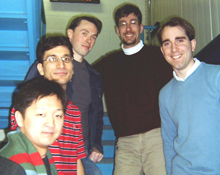 |
Thursday, March 9
11:00 a.m.
Academic Lecture Series - Curia II
Speaker: R. Plunkett, Fermilab
Title: Exploring the New World of Neutrino Physics – Lecture 1
2:30 p.m.
Theoretical Physics Seminar - Curia II
Speaker: M. Graesser, California Institute of Technology
Title: Towards a High Energy Theory for the Ghost Condensate
3:30 p.m.
DIRECTOR'S COFFEE BREAK - 2nd Flr X-Over
4:00 p.m.
Accelerator Physics and Technology Seminar (NOTE LOCATION) - 1 West
Speaker: R. Moore, Fermilab
Title: Overview of Tevatron Operations
Friday, March 10
3:30 p.m.
DIRECTOR'S COFFEE BREAK - 2nd Flr X-Over
4:00 p.m.
Joint Experimental Theoretical Physics Seminar - 1 West
Speaker: A. Schwartz, University of Cincinnati
Title: CP Violation and the Unitarity Triangle: Recent Results from Belle
|



Thursday, March 9
-Minnesota Wild Rice w/Chicken
-Tuna Melt on Nine Grain
-BBQ Ribs
-Chicken Casserole
-Buffalo Chicken Wrap
-Mexican Pizza
-Mandarin Chicken Salad
Wilson Hall Cafe Menu
|
 |
Thursday, March 9
Dinner
-Pasta Carbonados
-Stuffed Filet of Sole w/Crabmeat
-Sauteed Spinach w/Lemon Garlic Pine Nuts
-Salad of Field Greens, Pear & Shaved Parmesan
-Pecan Rum Cake
Wednesday, March 15
Lunch
-Pork Satay w/Peanut Sauce & Condiments
-Steamed Jasmine Rice
-Pineapple Coconut Coupe
Chez Leon Menu
Call x4512 to make your reservation.
|


|
 |
Shutdown Upgrades Focus on
Booster and Main Injector
|
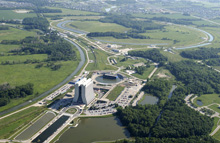 |
| The Booster and Main Injector upgrades will help to reduce beam loss, among other things. |
|
|
Accelerator upgrades during the current shutdown include two major modifications in the Main Injector and two major modifications in the Booster.
Main Injector: Four new collimators and seven upgraded magnets. Technicians are installing four collimators in the Main Injector line that delivers beam from the Booster to the Main Injector. Previously there were no collimators in this region. Technicians are replacing the existing quadrupole magnets in all Main Injector extraction/injection areas with new magnets that have a larger aperture--increased from 3.3" to 4.4"--to help reduce beam losses. Installation of five of the seven new magnets will require exposing Lambertson magnets to air. "The Lambertson magnets then must be rebaked to remove all the water to get a good vacuum again," explains Ioanis Kourbanis, Main Injector Dept. Head. Modifications to the cooling system in the (Main) Proton Injection kicker have also begun. Upgrading the cooling system will allow the kicker to fire at a higher rep rate, needed for NuMI slip stacking.
Booster: Magnet upgrades and relocation of dump site. Technicians are replacing the magnet system in the Linac-to-Booster line with magnets that can pulse at a higher rate without overheating, which should improve injection efficiency. The other Booster modification involves removing one of the Booster's two extraction regions. "We're removing the one that used to go to the main ring, which is now used as a dump," says Eric Prebys, Proton Source Dept. Head and Proton Plan project manager. "We found that having that second extraction region made it difficult to accelerate beam in the Booster without scraping." The dump site will be "relocated" to the MI-8 line, which goes to the Main Injector and MiniBooNE.
— Dawn Stanton
|

Simulating Supersymmetry
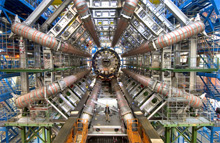 |
| The ATLAS detector under construction. Image courtesy of CERN. (Click on image for larger version.) |
|
|
One of the discoveries eagerly anticipated by particle physicists working on the world's next particle collider is that of supersymmetry, a theoretical lost symmetry of nature. Supersymmetry, often called SUSY, predicts the existence of a superpartner particle for every known particle.
Why the big hunt for SUSY's "sparticles"? Recent experiments have suggested that most of the matter in our universe is not made of familiar atoms, but of some new sort of "dark matter." Discovering a hidden world of sparticles will shed light on the nature of this dark matter, connecting observations performed at earth-based accelerators with those performed by astrophysicists and cosmologists.
Read More
|

House Committee on
Science Press Release, March 7, 2006:
House Passes Resolution Recognizing Importance of Engineering, Reaffirms Commitment to U.S. Competitiveness
WASHINGTON, March 7, 2006 – By voice vote, the House of Representatives today passed a resolution recognizing the importance of the engineering profession and supporting the goals and ideals of National Engineering Week.
The resolution, H. Res. 681 was introduced by Representative Daniel Lipinski (D-Ill.) and Research Subcommittee Chairman Bob Inglis (R-S.C.). Chairman Inglis managed floor consideration of H. Res. 681.
Read More
|
|
 |

|
CDF: Looking at Mass Bumps from a Different Angle |
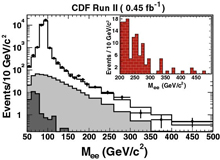 |
| The dielectron invariant mass
distribution from data (dots with
error bars) compared to the predictions of the Standard Model,
composed of diboson (dark gray), dijet (light gray), and Drell-Yan
Z->ee (white) models. A new Z-like boson would appear as a bump over the
Standard Model shapes. The inset shows a zoom-in of the data in the
search region. (Click on image for larger version.)
|
|
|
While the Standard Model (SM) has withstood all experimental tests to date, physicists believe it is incomplete. Many SM extensions predict new particles that could be produced in collisions at the Tevatron. Among these exotic particles are heavy neutral bosons, dubbed Z' (Z prime), whose decay to an electron and anti-electron (positron) would leave a distinctive signal in the CDF detector.
Measurements of the electron and the positron can be combined to reconstruct the mass of the pair, Mee. The presence of a heavy Z' would generate a peak, or "mass bump," in the Mee distribution at the Z' mass. An additional, more subtle property of the Z' is that it alters the preferred direction of the produced electron. By including this angular information, the Z' bump search becomes more sensitive than using Mee alone; for some Z' models it is the equivalent of having 25 percent additional data in the sample!
This analysis was performed on 0.45 fb-1 of dielectron data: Although it finds no evidence for Z' bosons, it does set the world's best direct limits on many Z' models. By collaborating with members of the Fermilab and Argonne Theory Divisions, the CDF physicists successfully tested more than 40,000 models of possible Z' bosons that had been theorized in a 2004 paper. While no Z's have been found yet, the authors hope that the new technique will be used to analyze future Tevatron or Large Hadron Collider data and return the first signs of new physics.
|
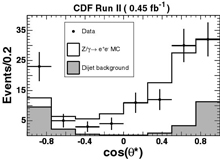
|
Above: The angle cos(θ*) of the electron momentum relative to the incoming quark momentum from the data compared to the predictions of the Standard Model. By including the angle in addition to Mee, the analysis gains additional sensitivity.
Below: The analysis was done by (left to right) Jedong Lee (Rochester), Catalin Ciobanu (Illinois), Sam Harper (Oxford), Kevin McFarland (Rochester), and Greg Veramendi (Illinois).
Not pictured: Gilles De Lentdecker, (Rochester) and Tom Junk (Illinois). (Click on images for larger version.)
|
|
Result of the Week Archive
|

|
Fermilab Film Series
The Fermilab Film Series will present Ran on Friday, March 10 at 8 p.m.
in Ramsey Auditorium. Tickets are $5.00 for adults, $1.00 for children (under 12),
and $2.00 for students with Fermilab ID and are sold only at the door. More information
can be found on the Film Series Web page.
Professional Development Schedule:
March 14: Excel Power User / Macros
March 15 - 17: Basic Perl Programming
March 21 & 22: Intro to Dreamweaver MX
April 4 - 6: Python Programming
April 20: FileMaker Pro 7 Level 1
May 16 - 18: JavaScript Programming
More information
Upcoming Activities
|
|





